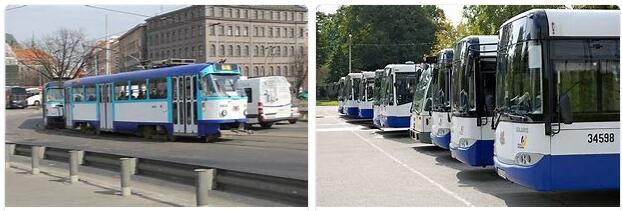Communication and ports. – Latvia had considerable importance for transit trade in the pre-war period, as appears from the fact that in 1913 28.2% of total Russian exports passed through the three Latvian ports of Riga, Ventspils and Liepāja (for 348 million rubles).) and 20.6% of imports (236.8 million). In recent years the transit of foreign goods has begun again (845 thousand tons in 1927 and 919 thousand in 1931) so that the port of Riga has seen its traffic grow up to about half of the pre-war period, like Ventspils, while Liepāja is still far from the pre-war figures.
Internal communications still reflect the events of the country in many respects. The main railway lines were built to open the Baltic ports to the hinterland and the gauge was the Russian one (1524 mm.). During the World War the Germans transformed a part of the Courland railways into the standard gauge (1435 mm.) And built some new narrow gauge lines, so that now Latvia covers 2755.7 km. of lines (13.7 for every 10 thousand residents and 4.2 for every 100 sq. km.), it has about three-quarters wide gauge (1746 km.), 319 with standard gauge, 49 with 1000 mm gauge, 365 of 750 mm., And 394 of 600 mm. A few more important lines have parallel sections of different gauge. The fact that the network was built in the service of Russia, it easily explains how communications between the different parts of the new state are sometimes very difficult, especially between the western and eastern parts. It should be added that the border lines have cut the railways here and there, so that from Jelgava to Liepāja, before a new northern line was built (1930-31), it was necessary to pass through Lithuanian territory. To obviate these drawbacks, efforts were also made to spread automotive services: in 1931, 144 lines were functioning, serving a network of 6518 km. There are 3855 cars in the country. The road network, somewhat better than in Lithuania, but barely poor in autumn and spring, is 30,692 km long, of which 8320 are maintained by the state. Inland navigation, both for the characters of the network (rapids, sand banks, long digressions, variable flow rates), and due to the climatic conditions (winter ice), it does not offer much favorable conditions. A passenger boat service is operated on the Lielupe, between Riga and Jelgava.
Merchant marine. – At the date of the declaration of independence (1918) the tonnage registered in the four ports of Riga, Liepāja, Ventspils, Ainaži, which, in 1914, was about 127,000 tons. gross, it was almost destroyed as the fleet was reduced to 45 ships for 11,146 tons. gross. But in fourteen years the reconstruction has taken place since (Lloyd’s Register, 1932-33) the fleet counts 114 ships (over 100 unit tons) per ton. 188,479, almost all steam powered. Eighteen of these ships exceed 2000 tons. unitary. However, the reconstruction took place through purchases abroad as the Latvian shipyards, technically and financially insufficient, cooperated in it to a minimum. The government could only finance the shipbuilding to a minimum extent, first by granting loans to shipowners (for a complex of lats 1,584,037, from 1919 to 1924), and in 1924 by creating the state mortgage bank; with mortgages granted by this has reached a complex of more than 2 1 / 2 million lats; rate of 6 1 / 2% repayment in six years. In 1929 cabotage was reserved for the flag; in 1930 the government allowed the free introduction of some shipbuilding materials.
Civil aviation. – It is controlled by the Air Council. In 1921 the Latvian Air Service Company (Latvijas Caisa Satiksmes Akciju Sabiedriba) was formed which, until 1926, managed the Riga-Königsberg and Riga-Helsinki airlines. After the dissolution of this company, in May 1926 the company “Deruluft” was founded in Riga, which manages the Riga-Berlin and Riga-Moscow lines with Dornier Merkur devices and the Riga-Tallinn and Riga-Leningrad lines with Junkers F. 13.
The military airport of Spilve, near Riga, is located on the left bank of the Daugava river, and part of it is used by civilian aircraft. The portion reserved for civil use is located in the SW. of the field.
Outside of military airports, there are no exclusively civilian airports in Latvia.
